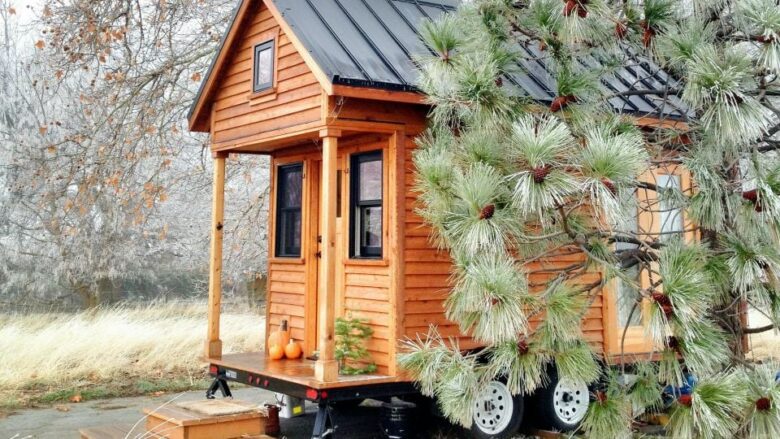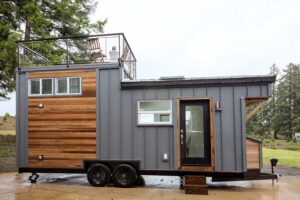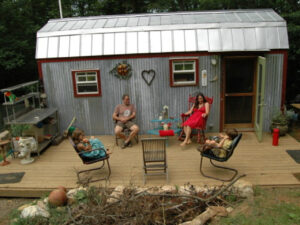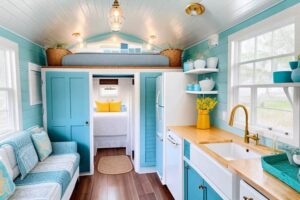If you think’more is more’, then the small living movement is more than just a trend. This is a lifestyle that changes everything. Micro-living, which means living in a space that is typically less than 500 square feet, encourages a mindset of simplicity, efficiency, and a strong connection to nature. People choose to live in smaller spaces to enjoy a better quality of life. As we look at the eight key benefits of living in a small space, we’ll see how this lifestyle offers a unique combination of personal, financial, and environmental benefits.
1. Simplified Lifestyle:
The idea of keeping things simple is at the heart of small-scale living. People who choose to live in smaller spaces need to think carefully about what is really important. This encourages a minimalist lifestyle that focuses on quality over quantity. This simplification means not only getting rid of the real things, but also getting rid of the irrelevant problems in life. therefore? A clearer mind, a more relaxed lifestyle and more time spent on activities and interests that really make life better.
2. Freedom from Debt:
The trend in small business is financial freedom. The cost of buying, owning and living in a tiny house is very low compared to the cost of a regular house. Spending much less money on living expenses frees up some money to save, pay off debt, or even become homeless. For many people, living in a small space is the key to financial independence and living without the constraints of money.
3. Environmental Benefits:
Sustainability is an important aspect of small homes. Because they are smaller, they use less energy to heat and cool, and they are often made from materials that are environmentally friendly. People who want to live in harmony with nature will appreciate this small impact on the world. People who choose to live in tiny homes are actively taking steps to reduce their impact on the environment. They practice environmental management ethics, which is becoming increasingly important in today’s world.
4. Freedom of Movement:
Small living communities are changing what it means to move around your home. Many tiny houses are portable, so the people living in them can move to a new location without having to change addresses. This ability to move allows you to live an exciting and fun life, knowing that the comforts of home are always close by. Whether you’re looking for a new job or just want to explore nature, micro-living allows you to live a free and active life.
5. Better Community Connections:
Living in a small space can help people feel more connected to each other. When internal privacy is less important, people are more likely to connect with each other and the community around them. The growing number of tiny house communities around the world also offer a sense of community and shared purpose, further strengthening the bonds between those who choose this lifestyle.
6. Personalization and Creativity:
Designing a tiny house requires a lot of imagination. With space at a premium, people need to think of new ways to store things so they can work better and express themselves. People who need creativity can style their homes according to their specific needs and tastes. This creates highly customized living spaces that reflect the people who live there and their values.
7. Value Experiences Over Things:
Living in a small space naturally shifts the focus from things to life events. When people don’t have much room for their things, we encourage them to find joy in events, relationships and personal growth. This perspective encourages people to live fuller, more rewarding lives, valuing the things that matter: relationships, adventure, and learning about themselves.
8. Possible Problems and Things to Consider:
There are many benefits to living in a small space, but there are also some problems. Zoning regulations, building codes and social norms can be difficult to understand. Living in a small space also requires creativity and adaptability, especially for people used to larger living spaces. Many people find that the benefits of living a simple, purposeful life far outweigh the problems.
Summary:
Tiny living is more than just a way to save money or cause less damage to the environment; it’s a lifestyle that values ease, freedom, and deep connections with others and the world around you. By following the concept of small living, people can live a fulfilling, sustainable life. This means that sometimes less is more.
FAQs:
1. What are the biggest cost savings when living in a tiny house?
The main cost savings come from lower costs of purchasing or building the home, lower energy bills due to less space and minimal maintenance costs. Furthermore, this lifestyle encourages you to spend less on non-essentials, saving even more money.
2. How do tiny homes promote a more sustainable lifestyle?
Tiny homes require fewer resources to build and maintain, use less energy for heating and cooling, and are often built with environmentally friendly materials, contributing to sustainability. A smaller ecological footprint supports a more sustainable lifestyle and reduces environmental impact.
3. Can a family live comfortably in a tiny house?
While living as a family in a small home presents unique challenges, such as maximizing space and privacy, many families find this not only possible, but beneficial. It encourages family bonds, outdoor activities and creative use of space. Planning and commitment to a minimalist lifestyle are key.
4. What should potential small business owners consider before making the switch?
Potential owners of smaller homes must consider zoning and building codes, the practicalities of downsizing their property, and the lifestyle changes required to live in a smaller space. Research and planning in these areas can ensure a smooth transition to small life.
5. How have people’s views on micro-life changed in recent years?
The perception of tiny living has evolved from a niche lifestyle choice to a mainstream housing option recognized for its economic, environmental and lifestyle benefits. As awareness grows, more and more people see micro-living as a viable and ideal option to simplify life and prioritize experiences over possessions.



